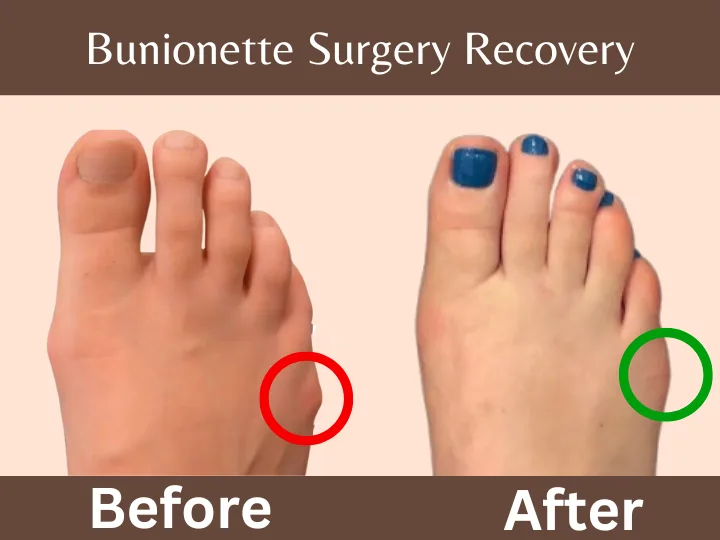Bunionette surgery, also known as tailor’s bunion surgery, is a procedure designed to relieve pain and discomfort caused by the bony bump on the outside of the foot near the little toe. For many, this surgery can lead to improved mobility and a better quality of life. However, a smooth recovery is critical to achieving these benefits. In this guide, we’ll walk you through the recovery process step-by-step, offering tips and insights to help you heal effectively.
What is Bunionette Surgery?
A bunionette, or tailor’s bunion, occurs when the bone at the base of the little toe protrudes outward, causing pain, redness, and swelling. This condition often develops due to genetic foot structure, improper footwear, or repetitive pressure on the foot.
Bunionette surgery involves removing or reshaping the protruding bone and may include realignment of the surrounding tissues. The procedure is typically recommended when non-surgical treatments like padding, orthotics, or anti-inflammatory medications fail to provide relief.
Immediate Post-Surgery Phase: The First Few Days
After bunionette surgery, your foot will be bandaged, and you may be required to wear a surgical shoe to protect the area. Here’s what you can expect:
- Pain Management: You will likely experience some pain and swelling. Over-the-counter pain relievers or prescribed medications can help manage discomfort.
- Elevation: Keeping your foot elevated above heart level reduces swelling and promotes blood circulation.
- Icing: Applying ice packs for 15-20 minutes every few hours can alleviate pain and swelling.
- Mobility Restrictions: Avoid putting weight on the affected foot. Crutches or a walker may be recommended to assist mobility during this phase.
Following your surgeon’s post-operative instructions is crucial to avoid complications and ensure proper healing.
Timeline for Recovery
Week 1-2: Rest and Recovery
During the first two weeks, the primary focus is on rest and protection of the surgical site.
- Swelling Management: Continue icing and elevating your foot. Swelling is normal but should gradually decrease.
- Wound Care: Keep the surgical dressing clean and dry. Avoid removing it unless instructed by your doctor.
- Mobility: Limit movement and avoid bearing weight on the foot. A scooter or crutches can help maintain mobility without putting pressure on the foot.
Week 3-6: Gradual Mobility
As the healing progresses, you may notice reduced pain and swelling. This phase often involves transitioning to light activities:
- Foot Exercises: Your doctor may recommend gentle exercises to restore flexibility and strength.
- Footwear: You may switch from a surgical shoe to comfortable, supportive footwear as advised.
- Monitoring Progress: Pay attention to any lingering pain, redness, or swelling, as these could indicate complications.
Month 2 and Beyond: Return to Normal Activities
By the second month, most patients can return to their daily routines with some precautions:
- Resuming Exercise: Activities like walking or light jogging may be possible, but high-impact exercises should be avoided until fully cleared by your surgeon.
- Foot Function: You should notice improvements in mobility and reduced discomfort in the affected area.
- Full Recovery: While many patients recover within 6-8 weeks, complete healing can take up to 3-6 months, depending on the extent of the surgery and individual factors.
Essential Tips for a Smooth Recovery
Here are some practical tips to ensure a smooth recovery process:
- Follow Medical Advice: Adhere strictly to your surgeon’s instructions, including medication schedules and follow-up appointments.
- Wear Appropriate Footwear: Post-recovery, choose shoes with ample toe space and cushioning to avoid putting pressure on the little toe.
- Avoid Overexertion: Gradually increase your activity level to prevent strain on the healing foot.
- Practice Good Hygiene: Keep the surgical site clean to reduce the risk of infection.
Addressing Potential Challenges During Recovery
Persistent Pain or Swelling
Mild pain and swelling are normal but should subside over time. If the pain persists or worsens, consult your doctor immediately.
Infection
Signs of infection include redness, warmth, pus discharge, or fever. If you notice any of these symptoms, contact your healthcare provider promptly.
Delayed Healing
Factors such as smoking, diabetes, or poor circulation can delay healing. Ensure you discuss these risks with your doctor before surgery and follow all recommended guidelines.
Long-Term Outlook After Bunionette Surgery
Successful bunionette surgery can lead to significant improvements in foot function, pain relief, and overall comfort. Here’s what to expect in the long term:
- Better Foot Alignment: The surgery corrects the alignment of the little toe, preventing future complications.
- Improved Mobility: You’ll likely find it easier to perform daily activities and enjoy physical exercise without discomfort.
- Preventing Recurrence: Wearing supportive footwear and avoiding excessive pressure on the foot can reduce the risk of a recurrence.
In some cases, physical therapy can enhance recovery by strengthening the muscles and improving flexibility in the foot.
Frequently Asked Questions
How long does bunionette surgery recovery take?
The recovery timeline varies but typically ranges from 6 to 8 weeks for most activities and up to 3-6 months for complete healing.
When can I walk without crutches?
Patients can often start bearing weight on the foot within 2-4 weeks, depending on the extent of the surgery and your doctor’s recommendations.
Can I drive during recovery?
Driving is generally not advised until you can safely bear weight on the foot and move it without pain. This usually happens within 4-6 weeks.
Will I have a scar after surgery?
While scarring is minimal, the incision site may leave a faint mark that fades over time. Proper wound care can minimize scarring.
Conclusion
Bunionette surgery recovery is a journey that requires patience, care, and adherence to medical advice. By understanding the recovery timeline, following post-operative instructions, and taking preventive measures, you can ensure a successful outcome.
For personalized advice or concerns about your recovery, consult your surgeon. A well-planned recovery is the key to enjoying the benefits of bunionette surgery and getting back to pain-free living.




